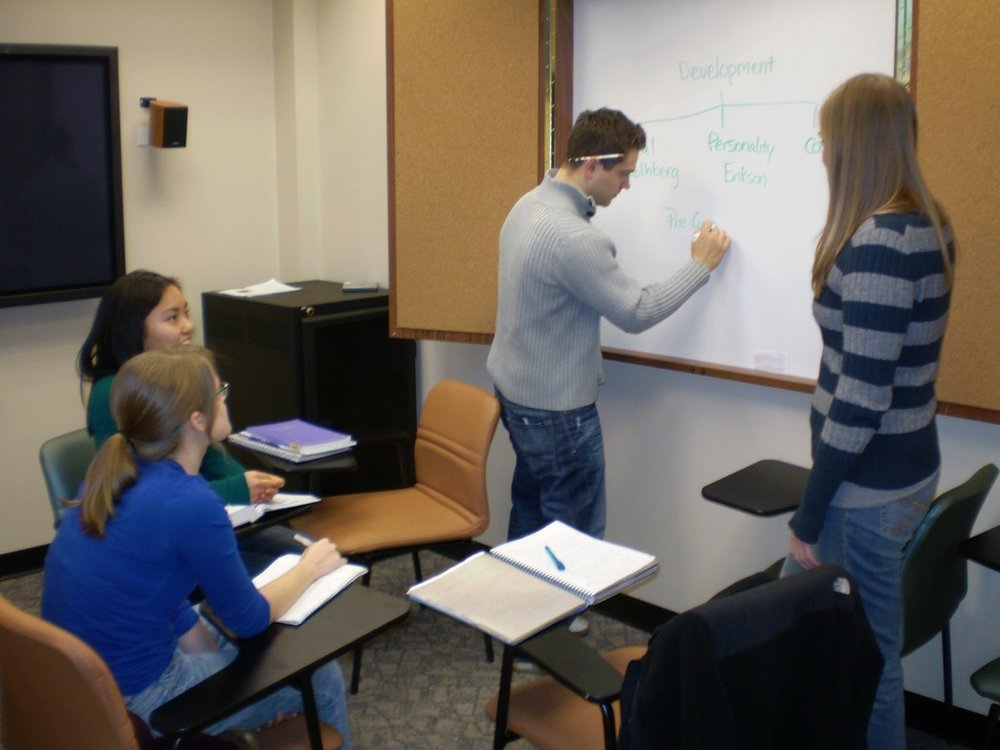
This blog focuses on my scholarship in my five research projects: learning assistance and equity programs, student peer study group programs, learning technologies, Universal Design for Learning, and history simulations. And occasional observations about life.
From the horses’ mouths: Reflections on transition from peer leaders.

World-wide peer learning programs support students in their transition to university. Peer leader support is distinctive, being closer to the learning experience or transition encountered. This paper explores transition into the first year of university through the reflections of peer leaders. It outlines two synergetic programs at the University of Wollongong (UOW): one supporting high school students in the early stages of transition to university (In2Uni); and the second supporting enrolled university students (PASS). Focus groups were conducted to elicit the voices of leaders reflecting on their own transition and experiences of mentoring peers through transition. The findings suggest peer leaders assist transitioning students to confront change; develop strong social networks; make connections within and across curriculum; and learn how to learn in the new academic context. It was found that peer leaders valued peer support in their own transition (or wished for it) and saw its ongoing significance for others in transition.
To download the complete annotated bibliography of more than 1,100 citations of postsecondary peer cooperative learning programs, click on the following link, http://z.umn.edu/peerbib
Assessing the impact of a muilti-disciplinary Peer Led-Team Learning program on undergraduate STEM education

There has been a national call to transition away from the traditional, passive, lecture-based model of STEM education towards one that facilitates learning through active engagement and problem solving. This mixedmethods research study examines the impact of a supplemental Peer-Led Team Learning (PLTL) program on knowledge and skill acquisition for students in introductory biology, chemistry, calculus and applied statistics courses. Results indicate program participants reliably outperform their matched pairs in courses that emphasize quantitative reasoning. Moreover, program participants report acquiring important insights about learning, collaboration, and engagement in undergraduate STEM education. These results are consistent with previous findings on PLTL and also provide insight into the roles of course context and student population on program outcomes.
To download the complete annotated bibliography of more than 1,100 citations of postsecondary peer cooperative learning programs, click on the following link, http://z.umn.edu/peerbib
2016 Apple TV App Directory

At the University of Minnesota where I am a history professor, Apple TV is integrated into a growing number of classrooms so that students can share video content through the projection television system. First-year students in the College of Education and Human Development receive an iPad upon arrival and use of it is integrated into many of their first-year courses.
The Apple TV has been an underappreciated technology that Apple has significantly improved through this third-generation unit. This annotated directory identifies the apps that I use on my Apple TV unit at home on a regular basis. There are many other apps that I do not profile simply because they require an additional charge for their use or are not of interest. Currently there is about 160 apps. I remember when I purchased my first iPhone and then with the first iPad and there were a relatively small number of apps. Now the library of Apple apps exceeds half a million. While I don’t expect the same exponential growth for Apple TV, their library will rapidly expand. Many of these Apple TV apps are also available for use on iPhones and iPads. If you have set up for automatic download of new apps on all your iOS devices, do not be surprised to see some of these apps appearing on other Apple devices.
The Apple TV device allows many free Internet video sources to be accessed through home televisions. Unless noted otherwise, all apps in this directory are free to download and use on Apple TV. There are others (especially games) that require a small fee to download (most under $5) and may also include in-app purchases for additional features or for games to obtain more resources. This abridged directory contains apps that are often free and frankly are of my taste. With more than 159 apps and additional ones being added weekly, this directory does not try to be inclusive of all of them.
Click on this link to download the free annotated directory of Apple TV apps.
History of Learning Assistance and Developmental Education: Mid 1990s to the Present
 The following excerpt is from my monograph, Access at the Crossroads. The history of learning assistance and developmental education is often overlooked, misunderstood, or incorrect. This segment of the history looks at recent history of the field. To find out more about my monograph, click on the box in the left column.
The following excerpt is from my monograph, Access at the Crossroads. The history of learning assistance and developmental education is often overlooked, misunderstood, or incorrect. This segment of the history looks at recent history of the field. To find out more about my monograph, click on the box in the left column.
Turbulence in postsecondary education defines the current phase of history. Learning assistance activities and services have been curtailed at a growing number of four-year institutions, especially large public universities. This change is concurrent with increased diversity of the student population, increased college enrollments, increased competition for institutional funds, and decreased percentage of operating funds from state governments for public institutions. Although the need for learning assistance has expanded, its resources have become scarcer.
In the late 1990s, the perception of learning assistance changed for some— and not for the better. Critics have been particularly harsh toward programs that used the term “developmental education” to describe themselves. Large, public four-year institutions are engaged in intense dialogue about this topic. The terms developmental education, compensatory education, and remedial education suffer from stigma. In 1998 Martha Maxwell noted, “Developmental education has become a euphemism for remedial with all the negative connotations that word implies.... Today, students taking developmental courses are stigmatized. . . In primary and secondary schools the term developmental education applies to programs for the mentally retarded” (Piper, 1998, p. 35). As remedial education engendered negative reactions from some policymakers, so did developmental education.
Several publications have prompted considerable conversation about improving the campus learning environment (Barr and Tagg, 1995; Lazerson, Wagener, and Shumanis, 2000). A number of learning assistance professionals have reinvented themselves as resources for the entire campus—students and faculty alike—by aligning with this paradigm of learning.
A result of the paradigm shift from teaching to learning led to creation of learning and teaching centers at some institutions. Although the name of these centers was the same, two variations were apparent. One type of learning and teaching center provides professional development for the teaching staff. Services include resource libraries, training programs for new instructors, ongoing mentoring programs, classroom observations with subsequent private consultations, and the like. A second type of learning and teaching center extends the professional development services for faculty by providing learning assistance services for students such as tutoring, learning skill workshops, drop-in learning centers, and credit courses.
Methods for operating these teaching and learning centers vary widely. An online search for these centers suggests that most were established at four-year institutions (Center for Teaching Excellence, 2009). Reviewing the Web sites for the centers suggests that they have been expressed differently based on administrative location under academic or student affairs. Those in student affairs tend to have a higher focus on delivery of learning assistance services for students. Those located under academic affairs more commonly focus on teaching faculty development activities. Another factor that has affected these centers is whether a faculty or staff member leads it. Those led by faculty members tend to be under academic affairs, those led by staff members most often under student affairs. Unlike the aforementioned learning assistance professional associations, no clear national organization represents these teaching and learning centers.
The teaching and learning center model has emerged to meet the broad needs that exist to assist student learning and faculty development. An online search for postsecondary teaching and learning centers identified several examples among prestigious institutions. Cornell University (Ithaca, New York), through its Center for Learning and Teaching (http://www.clt.cornell.edu), serves students through the learning strategies center (tutoring, workshops, supplemental classes), student disability services, and international teaching assistance development program (workshops to improve communication and pedagogical skills). Instructors can access teaching assistance services (individual consultations and workshops to improve teaching skills) and faculty services (individual consultations to improve teaching effectiveness). At Stanford University (Palo Alto, California), the Center for Teaching and Learning (http://ctl.stanford.edu/) provides faculty development opportunities and tutoring, learning skills workshops, and academic coaching for students.
As these examples illustrate, common practices of these expanded centers include providing academic assistance to all students enrolled in identified courses, publishing teaching effectiveness newsletters, conducting learning effectiveness workshops, providing teaching mentors, and consulting on innovative instructional delivery. Both illustrate how learning assistance appears very differently at these prestigious institutions in comparison with open access community colleges. Developmental courses are not provided at these institutions; instead, services for students focus on tutoring and noncredit learning strategies workshops.
Monitoring and evaluation of peer academic support programs in South African higher education institutions

The high failure and retention rates at universities despite peer academic support programs has necessitated the need for the present study to investigate how monitoring and evaluation is carried out to support the facilitators of these programs. The study adopted a qualitative approach, collecting data from a sample of 12 participants made up of program coordinators and peer academic facilitators. The results indicate that there is monitoring and evaluation of these programs by program coordinators and peer facilitators. This is achieved through observation during sessions, unannounced visits and support to facilitators. However, the structures and mechanisms of monitoring and evaluation are not strong enough to enhance effective implementation of the programs. It is concluded that although there are good peer academic support programs at this university under study, there is need for rigorous monitoring and evaluation as well as support by more qualified person.
To download the complete annotated bibliographny of more than 1,100 citations of postsecondary peer cooperative learning programs, click on the following link, http://z.umn.edu/peerbib
Research on group learning and cognitive science: A study of motivation, knowledge, and self-regulation in a larger lecture college Algebra class

At a research University near the east coast, researchers restructured a College Algebra course by formatting the course into two large lectures a week, an active recitation size laboratory class once a week, and an extra day devoted to active group work called Supplemental Practice (SP). SP was added as an extra day of class where the SP leader has students work in groups on a worksheet of examples and problems, based off of worked-example research, that were covered in the previous week’s class material. Two sections of the course were randomly chosen to be the experimental group and the other section was the control group. The experimental group was given the SP worksheets and the control group was given a questionand-answer session. The experimental group's performance was statistically significant compared to the control on a variety of components in the course, particularly when prior knowledge was factored into the data.
To download the complete annotated bibliography of more than 1,100 citations of postsecondary peer cooperative learning programs, click on the following link, http://z.umn.edu/peerbib
Exploring the emotional intelligence of student leaders in the SI context
 James, C., & Templeman, E. (2015). Exploring the emotional intelligence of student leaders in the SI context. Journal of the First-Year Experience & Students in Transition, 27(2), 67-81. Retrieved from http://www.ingentaconnect.com/contentone/fyesit/fyesit/2015/00000027/00000002/art00004?crawler=true
James, C., & Templeman, E. (2015). Exploring the emotional intelligence of student leaders in the SI context. Journal of the First-Year Experience & Students in Transition, 27(2), 67-81. Retrieved from http://www.ingentaconnect.com/contentone/fyesit/fyesit/2015/00000027/00000002/art00004?crawler=true
An exploratory study of the emotional intelligence (EI) of student leaders participating in a Supplemental Instruction (SI) program was conducted to determine whether a significant relationship exists between leadership effectiveness and EI as measured by the Bar-On Emotional Quotient Inventory (EQ-i) and to assess the impact of the leadership experience on EI scores through pre- and post-testing. The results revealed a statistically significant difference in the Total EQ-i of the more effective leaders as compared to the others. The more effective leaders also scored higher on all the EQ-i subscales, with the differences on Social Responsibility, Impulse Control, and Reality Testing being statistically significant. As for changes in EI, only the scores on the EQ-i Problem Solving subscale increased significantly between the pre- to post-testing sessions. Implications for practice and future research are addressed.
To download the complete annotated bibliography of more than 1,100 citations of postsecondary peer cooperative learning programs, click on the following link, http://z.umn.edu/peerbib
